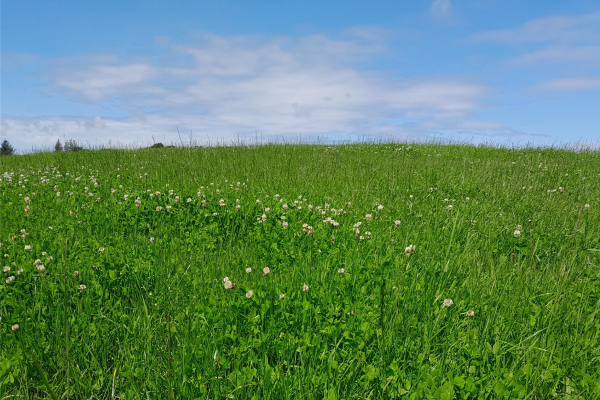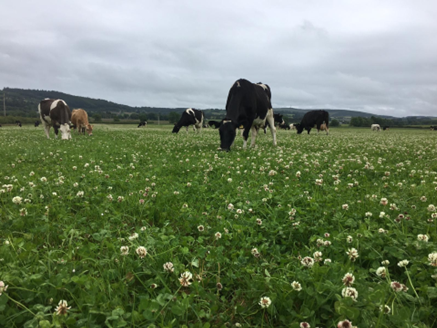Organic Conversion: Case Study Introduction
30 August 2023The key considerations, challenges and opportunities when bringing land under organic management
Leo Petrucci has farmed Outer Blair as an organic dairy unit since 1999. The farm lies within the Stranraer Lowland NVZ, bordering the Piltanton Burn and ranges from land class 3.1 to 5.3 on Calcareous Soils. 270 cross-bred cows average 6,800 litres with milk being sold to Muiller on an organic contract. Cows are paddock grazed from early Spring and a spring bean and spring wheat arable silage is grown to facilitate reseeding and to supplement silage rations in the winter months. In 2022, the opportunity arose to purchase the neighbouring farm, Kildrochat Mains, of 153 acres which had been run as a conventional dairy and latterly as a beef rearing unit.

Soil Health
“You can’t mask bad land” in an organic system. Leo’s years of experience as an organic producer have taught him this and he has found that drainage is the key to improving the quality of his ground. An extensive programme of drainage works have been carried out, with poor fields targeted in the winter months. A good drainage system allows soils to dry out quickly, improving soil structure, increasing soil temperature and improving ground conditions and field productivity. To gain an insight into soil fertility the entire farm was soil sampled at the outset, the average results were;
| pH | Phosphate | Potash | Magnesium |
|---|---|---|---|
| 5.7 | 9.8M+ | 213 High | 139M+ |
Challenges;
- Kildrochat Mains lies around 20m above sea level and so it is difficult to gain height to create run.
- The underlying subsoil is running sand which requires careful excavations to allow news drains to be laid.
- The farm has no stone or rock supply of its own so it all has to be imported, increasing drainage costs.
Opportunities;
- Increase the area of productive land on the farm.
- An improved drainage system will improve access for vehicles and stock to fields.
Grassland Management
Getting the opportunity to add adjacent land expands the options for how grazing and silage ground is managed. The dairy cows currently graze on a platform of 22, 6 or 7 acre paddocks, increasing after 1st cut when additional aftermath is added to the platform. Changes in weather patterns has meant that south west Scotland is experiencing more drought conditions during the grazing period. Increasing the number of paddocks to 30 will allow rotation length to be extended in times of drought to allow swards extra time to recover. Equally in wet weather having more paddock options allows grazing to be targeted at drier areas or those with easier access.
A programme of sward rejuvenation has begun at Kildrochat using specialist organic seed mixtures designed for cutting and grazing. Both grazing and silage swards are predominantly perennial ryegrass with white clover, red clover has been included in swards previously, but is not persistent enough for the 5-7 year rotation at Outer Blair. Reseeds are established with a nurse crop of spring wheat and spring beans to fix nitrogen for the grass crop and suppress weeds.
Challenges
- Weed suppression in heavily infested swards.
- Introducing herbal plants such as chicory to diversify the sward but avoiding over grazing by cows.
- Creating infrastructure to provide access and water to grazing paddocks.
- Early heading date in silage crops are compromising quality over yield.
Opportunities
- Increase the yield of grass grown across the unit through a programme of reseeding.
- Reconfigure field shapes to allow easier utilisation.
- Reassess seed mixtures to ensure the most appropriate choices are being made to suit soil type and delay heading date.

Infrastructure
Good infrastructure is the key to any successful grazing system. Stock must be able to move quickly and freely from the parlour to the paddock and cause minimal damage at gateways in wet weather. Outer Blair already had an extensive network of cow tracks and this is being extended across the Kildrochat Mains to allow new paddocks to be created. The maximum distance cows will walk to the milking parlour is 1.8km.
A reliable source of water is also important, with the ability to provide up to 100 litres per cow per day depending on yields. Outer Blair is fed by spring water while Kildrochat has a mains supply. A new network of 50mm waterpipes and 600 gallon water troughs in each paddock will be set up between the two holdings which will allow well water to be used for the majority of the year across the unit but the option will be available to connect to mains water supply in drought conditions.
Investment has already been made at Kildrochat in new perimeter fencing. Leo opted to use the Clipex metal fencing system with concrete posts as opposed to a conventional wooden post and stob system to increase the longevity of the fence.
Challenges
- Providing suitable cow tracks to optimise cow flow.
- Installing a water system to pump well water over a distance.
Opportunities
- Experiment with different track surfaces to improve cow comfort.

Future articles on ‘Organic Conversion in Practice’ series through the experience of a dairy farmer in South West Scotland will focus on soil health, grassland management and grazing infrastructure in detail.
Additional Resources
- SRUC pH Trials SRUC Scientific Poster Template (Portrait) (fas.scot)
- Valuing Your Soils Practical Guidance for Scottish Farmers fas.scot/downloads/valuing-soils-practical-guidance-scottish-farmers/
- Soil Association—Soil Management on Organic Farms https://www.soilassociation.org/media/7277/tech-guide-soil-management.pdf
- Soil Association—Grassland Productivity for Livestock factsheet-grassland-productivity-for-livestock.pdf
- Farm Advisory Service Organics Discussion Group from the Farm Advisory Service (fas.scot)
Sign up to the FAS newsletter
Receive updates on news, events and publications from Scotland’s Farm Advisory Service

